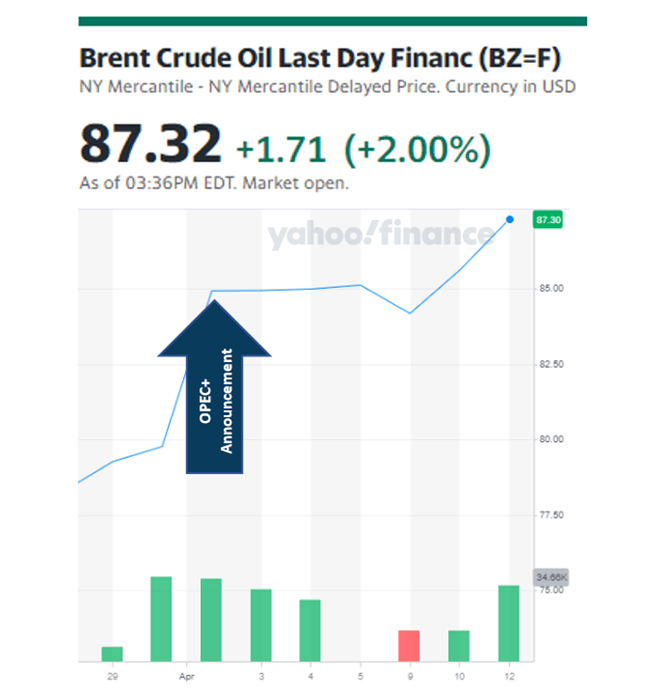OPEC+'s Oil Production Cuts Increase World Oil Prices
OPEC+'s Oil Production Cuts Increase World Oil Prices
The oil and gas industry is one of the most important and influential industries in the world, and the price of oil and gas affects everyone from consumers to businesses to governments. This week, the oil and gas industry was again impacted by the Organization of the Petroleum Exporting Countries (OPEC) and its allies' (“OPEC+”) decision to cut oil production.
On April 2, the coalition of oil producers known as OPEC+ announced it would cut oil production by 1.66 million barrels per day. That includes a previously announced cut by Russia of 500,000 barrels per day —some of which was likely to drop out of the market anyway because of Western sanctions.1
The output cut adds to a reduction of 2 million barrels a day agreed to in October by the Saudi-led OPEC and a group of other producers led by Russia. Taken together, the output cuts amount to about 3% of the world’s petroleum production taken off the market in seven months. The decision marks another moment when Saudi Arabia, once a reliable U.S. security partner, is setting energy policy at odds with Washington as the West confronts Russia over its invasion of Ukraine.2
The impact of this announcement is evident in the graphic below showing the closing prices for Brent Production.3
Market Summary - Brent Last Day Financial

As shown, prices for Brent Crude increased from approximately $76 per barrel to over $81 per barrel in response to the lower expected future supplies, an approximate 7% increase.
According to The Wall Street Journal, “The production cut will hit an oil market that was widely seen as tightly balanced between supply and demand, meaning it could lead to a longer-term rise in prices. If higher prices last, they could stoke inflation and complicate decisions for central bankers, who are caught between trying to tame rising prices and propping up a teetering banking system.”4
WTI Strip Prices Decrease
Spot prices and futures prices for the West Texas Intermediate (WTI) contract increased by approximately $4.75 per barrel in the near term and by approximately $1.00 per barrel over the longer term.
WTI Strip Prices - One Month Change

As shown, the oil price curve remains in a state of “backwardation,” reflecting the market’s expectation of lower future spot prices.
Oil Price Outlook
The price distribution below shows the crude oil spot price on March 12, 2023, as well as the predicted crude oil prices based on options and futures markets. Light blue lines are within one standard deviation (σ) of the mean, and dark blue lines are within two standard deviations.
WTI Crude Oil $/BBL

Based on these current prices, the markets indicate there is a 68% chance oil prices will range from $68.50 and $97.50 per barrel in mid-July 2023. Likewise, there is roughly a 95% chance that prices will be between $49.50 and $120.00. By mid-September 2023, the one-standard deviation (1σ) price range is $64.00 to $101.50 per barrel, and the two-standard deviation (2σ) range is $43.00 to $133.00 per barrel.
Key Takeaways
Remember that option prices and models reflect expected probabilities, not certain outcomes, but that does not make them any less useful. So far in 2023, crude oil prices have primarily remained within the range of $70 to $80 per barrel. As such, we have seen volatility decrease significantly compared to 2022, which is evidenced by the futures price ranges observed. As of March 15, 2023, the 1σ range had a spread of $37.50 per barrel, and the 2σ range has a spread of $90.00 per barrel. For comparison, in 2022 we observed 1σ and 2σ price ranges in excess of $65.00 and $150.00, respectively.
- “OPEC+ Cut Shows Saudi Geopolitical Ambitions,” Foreign Policy, April 6, 2023.
- “Saudi-Led Oil Producers to Lower Output Further,” The Wall Street Journal, April 3, 2023.
- Brent Crude Oil Last Day Financial
- “Saudi-Led Oil Producers to Lower Output Further,” The Wall Street Journal, April 3, 2023.






